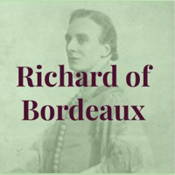
Overview
Synopsis
Richard of Bordeaux is the king of England. Only 19 years old--and having been a king for 10 of those years-- he is ready to cast off the council of uncles and advisors and assert his independence as a ruler. With his Queen Anne at his side, Richard slowly and deliberately eliminates the influence of his three uncles (York, Lancaster, and Gloucester) while putting trusted friends into key government positions. He is a young king with a world of possibilities in front of him. But Richard, even as he outsmarts and outmaneuvers his adversaries, is pulled into a political quagmire. After his beloved wife dies, he becomes the Richard II of the history books: immature, vindictive, and self-indulgent. With this course of his character, there can be only one tragic conclusion.
Richard of Bordeaux was an instant success at London’s New Theatre in 1933, making director John Gielgund (who also played the titular role) a dominant theatrical force. Inspired by Shakespeare’s Richard II, Elizabeth Mackintosh throws off typical portrayals and creates a sympathetic portrayal of a young man still searching for how to be a king.
Show Information
Context
Plot
Characters
| Name | Part Size | Gender | Vocal Part |
|---|---|---|---|
|
Lead |
Male |
Non-singer |
|
|
Lead |
Female |
Non-singer |
|
|
Lead |
Male |
Non-singer |
|
|
Lead |
Male |
Non-singer |
|
|
Supporting |
Male |
Non-singer |
|
|
Supporting |
Male |
Non-singer |
|
|
Supporting |
Male |
Non-singer |
|
|
Supporting |
Male |
Non-singer |
|
|
Supporting |
Male |
Non-singer |
|
|
Supporting |
Male |
Non-singer |
|
|
Supporting |
Male |
Non-singer |
|
|
Supporting |
Female |
Non-singer |
|
|
Supporting |
Female |
Non-singer |
|
|
Supporting |
Male |
Non-singer |
|
|
Supporting |
Male |
Non-singer |
|
|
Supporting |
Male |
Non-singer |
|
|
Supporting |
Male |
Non-singer |
|
|
Featured |
Either Gender |
Non-singer |
Songs
A song with an asterisk (*) before the title indicates a dance number; a character listed in a song with an asterisk (*) by the character's name indicates that the character exclusively serves as a dancer in this song, which is sung by other characters.
Monologues
Scenes
Key Terms
In theatre and literature, abdication refers to a character formally renouncing power, responsibility, or a throne. This act often triggers major shifts in a story’s conflict and themes. It can symbolize sacrifice, weakness, or transformation depending on the context.
A dramatic genre that dramatizes historical events, especially English history, as seen in Shakespeare’s plays.
Works not protected by copyright and available for free use or adaptation. Many classical plays, including Shakespeare's, fall into the public domain.
A fee paid to authors or rights holders for the performance of their work. Royalties ensure compensation for creative content in professional and amateur productions.
Videos
Sorry! We do not currently have videos for this guide.
Quizzes
Sorry! We do not currently have quizzes for this guide.
Themes, Symbols & Motifs
Sorry! We do not currently have learning modules for this guide.
Quote Analysis
Sorry! We do not currently have learning modules for this guide.
